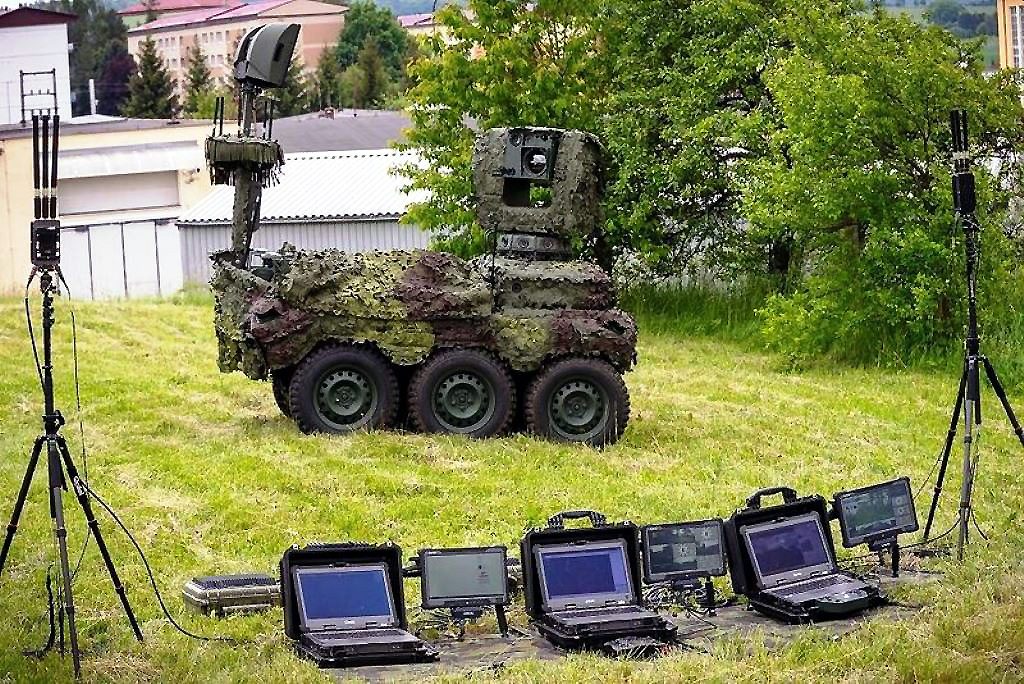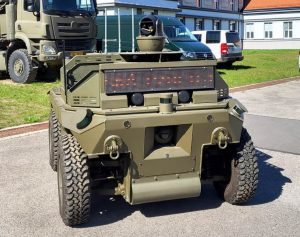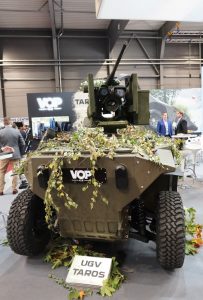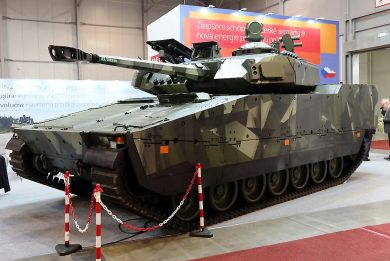
VOP CZ develops new unmanned ground vehicles
At the Future Forces Forum, which took place mid-October in Prague, the stand of VOP CZ, the local champion in the land systems domain, was dominated by its unmanned ground vehicles (UGVs), some of which are about to be delivered to the Czech Army, while other are in full development.
The involvement of VOP CZ in the UGV field dates back to 2013, while previously the company had been involved in numerous production programmes, such as those of 107 Pandur II 8×8, 300 armoured cabins for Ajban wheeled vehicles on behalf of Nimr of the UAE, as well as modernisation programmes, including those of main battle tanks such as T-72M4-CZ and T-55.
The family of UGVs developed by VOP CZ is named TAROS, the acronym for TActical RObotic System, the name regrouping a series of development platforms as well as some production ones, the latter delivered to the Czech Army for testing in mid-2020 and which should be now under production by VTÚ, the Czech Military Technical Institute. EDR On-Line understood these are derivatives of the company evolving prototypes, based on national army requirements.
The first one is a reconnaissance UGV known as UGV-Pz, which features a 6×6 chassis and is designed to be fitted with different recce packages. Maximum speed over rough terrain is 15 km/h, with a range on road of over 20 km. It can cope with a 30% slope and a same angle side slope, and its dimensions are 2,4 x 1,7 x 2,3 meters with the sensor package in transport position. The purposely designed superstructure hosts a Thales Squire battlefield surveillance radar installed on a telescopic mast, and an optronic package hosted by a pan-tilt head allowing full rotation on 360° and an elevation between –25° and +65°. The optronic package includes a day TV camera with a 59° x 46° wide field of view and a 2.2° x 1.6° narrow field of view, and an uncooled thermal camera which field of view goes from 35° x 27° to 4.4° x 3.3°. A laser rangefinder with an 80-20,000 meters range is also installed, as well as a laser marker with a 15 km range. The data link between the UGV Pz and the control station has a range of 3-5 km. The overall mass of the system is 1,870 kg. As all TAROS-derived UGVs, the UGV-Pz features independent steering wheels that allow circular turning, crab side movement, reduced turning radius, beside of course conventional movement. Propulsion in the case of the recce UGV is all-electric, batteries providing not only power to wheels independent electric motors, but also long time of operation to the sensors package. Currently the UGV Pz is fitted with an autonomy package that allows it to move on its own in different modes, follow me, obstacle detection and avoidance, waypoint planning, however further modes are under development, such as patrol functions, both static and dynamic.
The other UGV developed on Czech Army requirements is the UGV SOM 6, SOM standing for Systém Ochrany a Monitorování, which is Protection and Monitoring System. Although no technical data are provided, EDR On-Line understands it is also based on the TAROS family, albeit it has a 4×4 configuration compared to the 6×6 of the previously described UGV Pz. It is equipped with volumetric Lidars, which are used both as sensors for providing a degree of autonomy allowing the UGV to avoid bostacles, as well as for detecting intruders in the controlled perimeter. An optronic package with day/night cameras provides an identification capability, while a two-way audio communication system permits to listen any suspect noise and eventually send out warning messages. The SOM 6 is already in use, Military Police units tasked for site security fully exploiting it to reduce the manpower footprint required for that task. To increase its range the propulsion system is hybrid, an on-board diesel generator allowing recharging the batteries.
At the Future Forces Forum it was possible to see the TAROS V2, a demonstrator based on a modular concept that allows bringing it from a 4×4 up to an 8×8 configuration. However the starring UGV was the new TAROS V4, the fourth iteration of UGVs developed by VOP CZ. Compared to the V3 improvements were made in the propulsion and driving system, as well as in the logic that allows autonomous driving. New, more efficient batteries have been adopted, which together with an improved power management system allow having a reduced number of batteries for a higher range.
The TAROS V4 is 2.83 meters long, 1.78 meters wide and 1.85 meters high, and has a combat weight of 1,850 kg, 350 kg being of payload. Maximum speed on paved road is 15 km/h, on dirt road 10 km/h, while on difficult terrain and/or in autonomous mode speed drops between 1 and 5 km/h. This UGV is building on company specifications, taking into consideration current trends in order to develop a platform oriented to the wider possible export market. The 341 Ah battery pack ensures a 40 km range however a serial hybrid configuration with a diesel generator used to recharge the battery allows to considerably increasing that range. At the Future Forces Forum the TAROS V4 was fitted with a remotely controlled weapon system armed with a 12.7 mm machine gun, however the brochure available described a C-UAS version, fitted with the ReGuard 3D radar developed by Retia. An X-band radar with an AESA antenna, it is capable to detect a UAS with a 0.01 m2 radar cross section at 6.5 km, a bigger one with a 0.1 m2 RCS at 11 km, and an airplane with a 1 m2 RCS at 18 km and up to 3,000 meters altitude. The radar head weighs 66 kg, the antenna being 0.65 meters wide, 0.75 meters high and 0.235 meters thick, it can be easily integrated on a UGV such as the TAROS V4. According to company sources the platform is now fully finished, while the autonomy package is being finalised, and the system will be ready for presentations to potential customers in early 2023.
This is however definitely not the last step in the TAROS family development, a new one that will probably be named V6 being already in the pipeline.
Photos courtesy VOP and P. Valpolini







